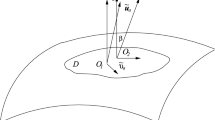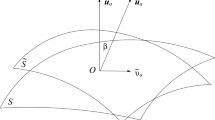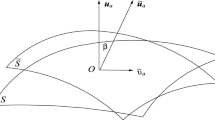Abstract
We employ a perturbative analysis to study the evolution of large-scale peculiar velocity fields within the framework of Newtonian gravity and then compare our results to those of the corresponding relativistic treatment. In so doing, we use the same mathematical formalism and apply the same physical approach. This facilitates a direct and transparent comparison between the two treatments. Our study recovers and extends the familiar Newtonian results on the one hand, while on the other it shows that the Newtonian analysis leads to substantially weaker growth-rates for the peculiar velocity field, compared to the relativistic approach. This implies that, by using Newton’s rather than Einstein’s theory, one could seriously underestimate the overall kinematic evolution of cosmological peculiar motions. We are also in the position to identify the reason the two theories arrive at such considerably different results and conclusions.

Similar content being viewed by others
Notes
Throughout this manuscript Greek indices run from 1 to 3, while Latin ones take values from 0 to 3.
Round brackets indicate symmetrisation, square ones antisymmetrisation and angled brackets denote the symmetric traceless part of second-rank tensors. Therefore, \(\sigma _{\alpha \beta }= \partial _{(\beta }u_{\alpha )} -(\partial ^{ \mu }u_{\mu }/3)h_{\alpha \beta }\).
Applied to a homogeneous system, Poisson’s equation leads to an inconsistency that is typically bypassed by appealing to the so-called “Jeans swindle” (e.g. see Binney and Tremaine (1987)). There is no such problem in relativity.
Typical Newtonian studies of peculiar motions introduce physical (\(r^{\alpha }\)) and comoving (\(x^{\alpha }\)) coordinates, with \(r^{\alpha }=ax^{\alpha }\). The time derivative of the latter leads to \(v_{t}=v_{H}+v_{p}\), where \(v_{t}=\dot{r}^{\alpha }\), \(v_{H}=Hr^{\alpha }\) and \(v_{p}=a\dot{x}^{\alpha }\) are the total, the Hubble and the peculiar velocities respectively. On an FRW background, the above velocity relation is equivalent to Eq. (10). Also note that the mean peculiar velocity (\(\tilde{V}\)) is given by the integral \(\tilde{V}=(3/4\pi r^{3})\int _{x< r}\tilde{v}{\mathrm{d}}x^{3}\), with \(\tilde{v}^{2}= \tilde{v}_{\alpha }\tilde{v}^{\alpha }\) and with \(r\) representing the radius of the moving region.
By construction, the CMB frame is the coordinate system where the CMB dipole vanishes (e.g. Ellis et al. (2012)). Put another way, the CMB frame is the rest-system of the (fictitious) idealised observers that follow the smooth Hubble expansion. Real observers, living in typical galaxies like our Milky Way, have nonzero peculiar velocities relative to the Hubble frame. Clearly, in the unperturbed background, these two coordinate systems coincide.
It should be made clear that the term homogeneous/inhomogeneous refers to the type of the differential equation and not to the homogeneity/inhomogenetiy of the space.
Setting both \(A_{a}\) and \(\tilde{A}_{a}\) to zero imposes a strict constraint on the peculiar velocity, demanding that \(\tilde{v}_{a}^{\prime }=-(\Theta /3)\tilde{v}_{a}\). The latter implies that \(\tilde{v}_{a}\propto a^{-1}\) on all scales. Given that peculiar velocities start very weak at recombination, such a result is incompatible with the observations and the widespread presence of large-scale bulk flows in the universe (see also § 3.2 in Tsaprazi and Tsagas (2020) for additional discussion).
The assumption of a Friedmann background, where all perturbations (including the peculiar velocity) vanish, ensures the gauge invariance of the study (Stewart and Walker 1974)
Treating the \(u_{a}\)-field as both shear-free and irrotational at the linear level is not essential for this study, as well as for that of Tsaprazi and Tsagas (2020), since neither of these variables is involved in the subsequent calculations. One may therefore relax these kinematic assumptions and in so doing broaden the range of the relativistic studies. Nevertheless, setting \(\sigma _{ab}=0=\omega _{ab}\) facilitates the connection with the earlier quasi-Newtonian studies (see also footnotes 12, 13 below). Note that the vanishing of the 4-acceleration in the tilted frame of the matter follows from the absence of pressure. On the other hand, setting \(\tilde{q}_{a}=0\) implies aligning the \(\tilde{u}_{a}\)-field with the energy frame, where the energy flux vanishes, though the particle flux is generally nonzero.
In Maartens (1998) and also in Ellis et al. (2001), \(v_{a}\) is the peculiar velocity of the matter relative to the quasi-Newtonian frame. This means that one can recover Eqs. (36a) and (36b) from the expressions given in Maartens (1998) and in Ellis et al. (2001) by simply replacing \(v_{a}\) with \(-v_{a}\) in those relations.
The Newtonian version of Eq. (37) reads \(\dot{\Delta }_{\alpha }= -\mathcal{Z}_{\alpha }\), with \(\Delta _{\alpha }= (a/\rho )\partial _{\alpha }\rho \) and \(\mathcal{Z}_{\alpha }= a\partial _{\alpha }\tilde{\Theta }\) (Ellis 1990). The absence of an acceleration term in the evolution formula of \(\Delta _{\alpha }\), which reflects the fact that there is no energy-flux contribution to the gravitational field in Newton’s theory, explains why (37) has no close analogue in Newtonian gravity and why the latter cannot reproduce the relativistic results.
In the quasi-Newtonian studies, the 4-acceleration is given by the gradient of an effective gravitational potential (i.e. \(A_{a}={ \mathrm{D}}_{a}\varphi \), with \(\varphi \) representing the potential). This is possible due to the irrotational and shear-free nature of the associated reference frame. Also, the propagation formula of \(A_{a}\) is obtained after introducing the ansatz \(\dot{\varphi }=-\Theta /3\) for the evolution of the potential. Then, instead of Eq. (38), one arrives at the expression \(\dot{A}_{a}=-2HA_{a}- (\kappa \rho /2)v_{a}\) (Maartens 1998; Ellis et al. 2001). Here, we do not employ a potential, which explains why the irrotational and shear-free assumption for the \(u_{a}\)-field is not essential (though it helps to associate with the quasi-Newtonian treatments – see also footnote 9 earlier and footnote 13 next).
When the \(u_{a}\)-field is both irrotational and shear-free, the peculiar vorticity vanishes at the linear level (Maartens 1998). Relaxing the nonzero shear constraint, while keeping the rotation to zero, ensures that the antisymmetric components of both \(\Delta _{ab}\) and \(\mathcal{Z}_{ab}\) vanish to first approximation (given that \(\Delta _{[ab]}=-3a^{2}H\omega _{ab}\) and \(\mathcal{Z}_{[ab]}=3a^{2}\dot{H}\omega _{ab}\) to linear order (Ellis et al. 1990)). In the absence of such vortex-like distortions, the linear evolution of the peculiar vorticity is governed by the homogeneous differential equation \(\dot{\varpi }_{ab}=-2H\varpi _{ab}\). After equipartition, the latter accepts the solution \(\varpi \propto t^{{-4}/3}\propto a^{-2}\), just like its Newtonian counterpart (see Eq. (19) in § 3.2 earlier).
As stated in footnote 6, the term homogeneous/inhomogeneous refers to the type of the differential equation and not to the homogeneity/inhomogenetiy of the host spacetime, or of the perturbations. Note that isolating and solving the homogeneous components of the relativistic differential equations ensures that we proceed on equal footing with the Newtonian study and therefore facilitates the direct comparison of the two treatments. Physically speaking, neglecting the inhomogeneous parts of (39) and (40) implies taking the long-wavelength limit of their solutions (see also § 4.2 in Tsaprazi and Tsagas (2020)).
References
Binney, J., Tremaine, S.: Galactic Dynamics. Princeton University Press, Princeton (1987)
Colin, J., Mohayaee, R., Sarkar, S., Shafieloo, A.: Mon. Not. R. Astron. Soc. 414, 264 (2011)
Ehlers, J.: Abh. Maiz. Akad. Wiss. Lit. 11, 1 (1961)
Ellis, G.F.R.: In: Sachs, R.K. (ed.) General Relativity and Cosmology, p. 104. Academic Press, New York (1971)
Ellis, G.F.R.: Mon. Not. R. Astron. Soc. 243, 509 (1990)
Ellis, G.F.R., Tsagas, C.G.: Phys. Rev. D 66, 124015 (2002)
Ellis, G.F.R., Bruni, M., Hwang, J.: Phys. Rev. D 42, 1035 (1990)
Ellis, G.F.R., van Elst, H., Maartens, R.: Class. Quantum Gravity 18, 5115 (2001)
Ellis, G.F.R., Maartens, R., MacCallum, M.H.A.: Relativistic Cosmology. Cambridge University Press, Cambridge (2012)
Hawking, S.W.: Astrophys. J. 145, 544 (1966)
Heckmann, O., Schücking, E.: Z. Astrophys. 38, 95 (1955)
Ma, Y.-Z., Pan, J.: Mon. Not. R. Astron. Soc. 437, 1996 (2014)
Maartens, R.: Phys. Rev. D 58, 124006 (1998)
Mohayaee, R., Rameez, M., Sarkar, S.: 2020. arXiv:2003.10420
Nusser, A., Davis, M.: Astrophys. J. 736, 93 (2011)
Nusser, A., Dekel, A., Bertschinger, E., Blumenthal, G.R.: Astrophys. J. 379, 6 (1991)
Padmanabhan, T.: Structure Formation in the Universe. Cambridge University Press, Cambridge (1993)
Peebles, P.J.E.: Astrophys. J. 205, 318 (1976)
Peebles, P.J.E.: The Large-Scale Structure of the Universe. Princeton University Press, Princeton (1980)
Raychaudhuri, A.K.: Astron. Astrophys. 43, 161 (1957)
Spyrou, N.K., Tsagas, C.G.: Mon. Not. R. Astron. Soc. 388, 187 (2008)
Stewart, J.M., Walker, M.: Proc. R. Soc. A 341, 49 (1974)
Tsagas, C.G., Kadiltzoglou, M.I.: Phys. Rev. D 92, 043515 (2015)
Tsagas, C.G., Challinor, A., Maartens, R.: Phys. Rep. 465, 61 (2008)
Tsaprazi, E., Tsagas, C.G.: Eur. Phys. J. C 80, 757 (2020)
Turnbull, S.J., et al.: Mon. Not. R. Astron. Soc. 420, 447 (2012)
Watkins, R., Feldman, H.A., Hudson, M.J.: Mon. Not. R. Astron. Soc. 392, 743 (2009)
Acknowledgements
KF acknowledges support from the General Secretariat for Research and Technology (G.S.R.T.) and from the Hellenic Foundation for Research and Innovation (H.F.R.I.), under the “First Call for H.F.R.I. Research Projects to support Doctoral Candidates” (Project Number: 114). CGT was supported by the Hellenic Foundation for Research and Innovation (H.F.R.I.), under the “First Call for H.F.R.I. Research Projects to support Faculty members and Researchers and the procurement of high-cost research equipment grant” (Project Number: 789).
Funding
This study was supported by the General Secretariat for Research and Technology (G.S.R.T.) and by the Hellenic Foundation for Research and Innovation (H.F.R.I. – Project Numbers: 114 and 789).
Author information
Authors and Affiliations
Corresponding author
Ethics declarations
Conflict of interest
No conflict of interest.
Additional information
Publisher’s Note
Springer Nature remains neutral with regard to jurisdictional claims in published maps and institutional affiliations.
Rights and permissions
About this article
Cite this article
Filippou, K., Tsagas, C.G. Large-scale peculiar velocity fields: Newtonian vs relativistic treatment. Astrophys Space Sci 366, 4 (2021). https://doi.org/10.1007/s10509-020-03912-4
Received:
Accepted:
Published:
DOI: https://doi.org/10.1007/s10509-020-03912-4




